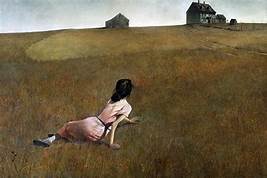By Sam Ben-Meir


NEW YORK — “He paints the soul, not just an image.” So begins the new documentary by PBS, featuring the life and work of Andrew Wyeth, and introducing viewers to one America’s great twentieth century painters – an artist whose work appealed to critics and audiences alike, an artist who spoke in oil paint a poetry reminiscent of Robert Frost, utterly American, elemental, mysterious, and not afraid to face the violence and darker corners of the human mind and imagination.
Wyeth was effectively raised to be an artist: his father, N.C. Wyeth was a major American illustrator who excited his children’s imagination. The father insisted that creative adults carry with them the spirit of childhood, and never lose the ability to play. Tragically killed in 1945, along with his grandson (Andrew’s nephew) when the car he was driving was struck by a train, N. C. Wyeth’s abrupt death had a major effect on the son: “It changed me from just painting pictures into painting a reality with an edge, with a meaning. His death really gave me a meaning to paint.”
There was a voyeuristic aspect to Wyeth’s work: He liked to be a fly on the wall as it were, and was fortunate to have neighbors in Chadds Ford, Pennsylvania, such as the Kuerners, who would essentially let him come and go as he pleased, “like a ghost”, and paint their daily life on the farm. This was not “a quaint farm” as Wyeth points out. There was a certain violence intrinsic to the Kuerner farm – and this undoubtedly attracted Wyeth whose work exudes a toughness, a sadness, and a poignant awareness of death.
One of the paintings to come out of Wyeth’s time at the Kuerner farm is Groundhog Day (1959), a work that reveals Wyeth at the height of his powers. It is a painting of the Kuerner’s kitchen, and the idea for it was born as he sat having lunch there. The painting was preceded by dozens of sketches, which Wyeth drew from memory. He began by drawing Mrs. Kuerner and the dog Nellie, but gradually he realized the story he wanted to tell, and a process of simplification took place as the key image emerged: the empty table waiting for Karl to come home – though Karl is absent, the painting is a more a portrait of him than were he actually there. In the foreground there is nothing but a white plate, cup and saucer and a knife. Through the window we see a threatening log with a jagged end. “I wanted you to feel the enclosure of the building and yet the country outside” Wyeth says. Indeed, outside there is chaos and violence; inside there is order and a kind of quasi-divine light.
Viewers also get an introduction to Wyeth’s paintings of black friends and companions. The artist claims at one point that “I didn’t paint them because they were black people. I painted them because they were my friends. I always felt that blacks have been painted very poorly. I’m not saying that I’ve done it well. They’ve been caricatured.” Among the black men that Wyeth painted is James Loper (1952), who walks in shoes that are cut out to get air, while his tattered pants are held up with belt made from a horse’s harness. Wyeth could paint men who were “mentally challenged,” such as Loper, or drifters struggling with alcoholism, but he always finds the dignity in his subjects, “no matter how difficult their lives were.”
The film touches on “Christina’s World,” purchased by the Museum of Modern Art of 1949, and one of the truly iconic works of the twentieth century. Its ubiquity can make it difficult to see the work with fresh eyes – to appreciate the immense power of this work, as a depiction of yearning, of humana longing. The subject of the painting, Christina Olsen was, like of other Wyeth’s, afflicted in some particular way (she seems to have suffered from a form of genetic polyneuropathy) – yet she is treated with a deep sense of humanity, in all of its tragic beauty.
Wyeth’s popularity, and commercial success, contributed to the view among some of his critics that Wyeth was essentially a regionalist painter, too easy and accessible, that his realism was out of step with the avant-garde, the burgeoning abstract expressionism of figures such as Pollack, de Kooning, and Rothko. The truth is that Wyeth’s art shares a great deal more with the abstract artists than it might appear at first glance. Some of Wyeth’s watercolors, for example, demonstrate that his brush was capable of energetic and expressive splashes such as we might associate with Franz Kline’s seminal black and white paintings. Moreover, in works such as River Cove (1958), for example, we find Wyeth verging on outright abstraction, and structuring the composition almost like a Mark Rothko painting.
The film finally takes up the disclosure of the Helga pictures, the more than two hundred and forty paintings and drawings of Helga Testorf, a neighbor of Wyeth’s in Chadd’s Ford, who posed nude and clothed over the course of fifteen years – unbeknownst to Wyeth’s wife Betsy, who was also in effect his business manager. In answer to the question of why he kept the paintings secret, Wyeth explained, “All of a sudden I saw this girl… She personifies everything I feel … I’m not going to tell anyone about this. I’m just going to paint it.” Many of the pictures Wyeth was creating concurrently were related to the Helga pictures, so that they allow us to see his larger body of work in a new light. They are undoubtedly some of Wyeth’s finest work, in terms of their technique, composition, and subject matter, which has an undoubtedly erotic element.
As one of the commentators notes, there was a shift that began around 2000 and which Wyeth was fortunately alive to appreciate, where critics and audiences began to move beyond the facile opposition between realism versus abstraction, and it became possible to see his work as no less modern than the abstract expressionists. He painted until the end – and even as he lay dying, unconscious, his hands were still moving, drawing. “Do the things that are your own. Paint your life.” That seems to be that principle that guided Wyeth, and the result is one of the great bodies of American painting.
The documentary may be viewed via pbs.org/americanmasters.
*
Sam Ben-Meir is a professor of philosophy and world religions at Mercy College in New York City.